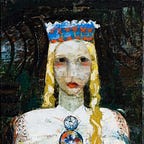Imaginary Latvian Peasant Wives and Girls with Colorful Skirts
in Marguerite Yourcenar’s Coup de Grâce (1939)
I remember our swims at dawn in the fresh lake water, or in the half-salt of the estuaries, where our feet left identical imprints on the sand, all quickly absorbed by the powerful suction of the sea. There were noonday rests in the hay where we discussed the problems of the time, chewing impartially at grass or tobacco, certain of doing far better than our elders and never suspecting that we were reserved only for other follies, and new catastrophes. In winter we skated together, or sometimes passed the short afternoons at that strange game of “Angels,” where you lie with arms outspread to trace wings upon the snow. And then came the good nights of heavy slumber on Lettish farms, when the peasant wives, appalled but touched, too, by our boyish appetites in those times of food restrictions, gave the best featherbeds and the “great room” to their young guests.
There was no lack of girls, either, in that northern Eden isolated in the midst of war: Conrad would gladly have attached himself to their colorful skirts had I not treated all such fancies with scorn.
Marguerite Yourcenar, Coup de Grâce (1939), translated from the French by Grace Frick.
